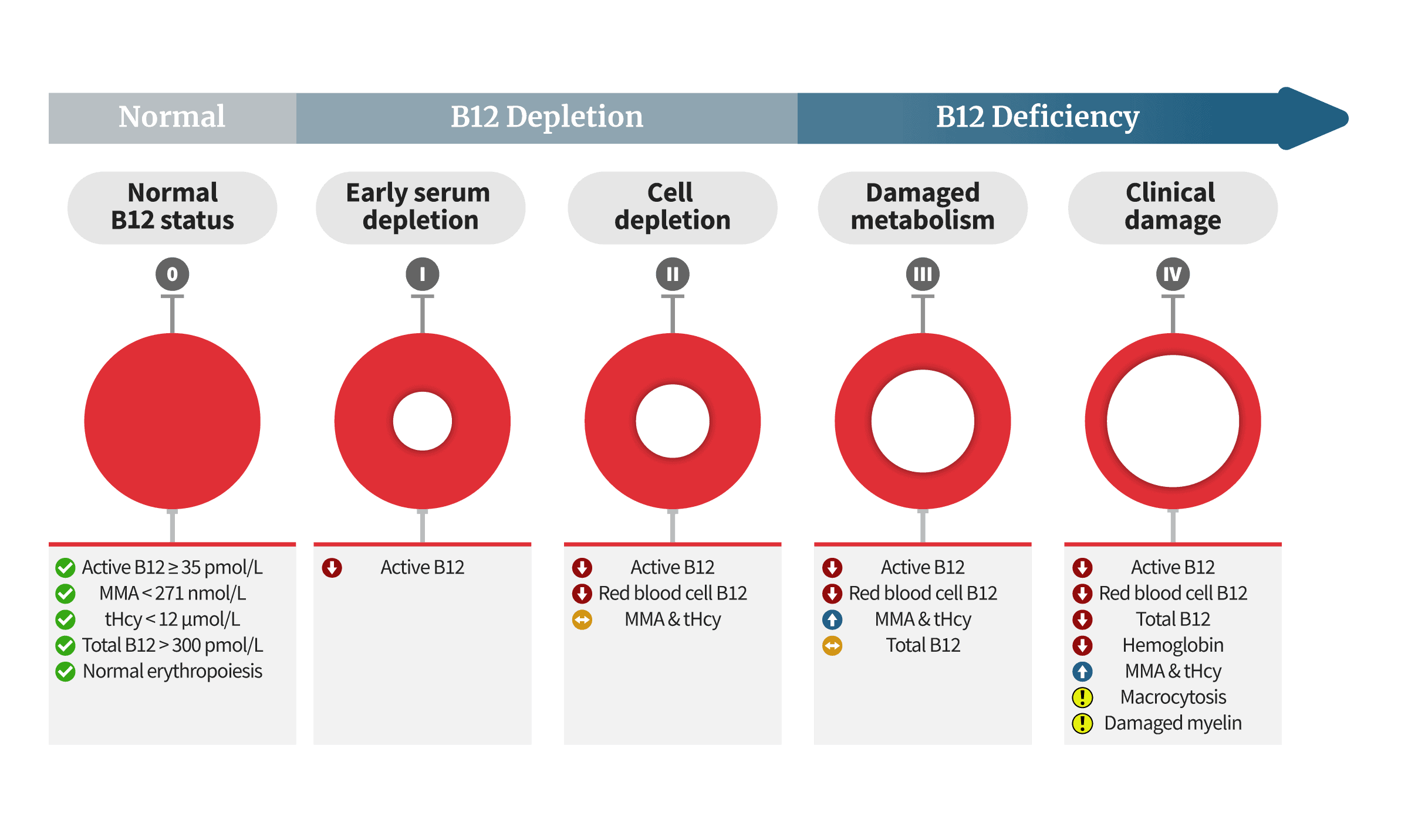What are the 4 stages of B12 deficiency? First, let’s get the basics right:
B12 is the only vitamin that contains a trace element, cobalt, which is why it’s called cobalamin. You won’t find B12 in plants, and animals can’t produce it either. Instead, bacteria that feed on cobalt-rich sources, like grass, produce B12 in the guts of ruminant animals. Other creatures, including humans, obtain B12 by eating these animals.
Your body can store B12 for several years. Only when these stores are depleted will you notice symptoms, progressing through four stages of B12 deficiency. In the final stage, you’ll start to experience unusual neurological signs. At this point, permanent damage can take place, as the nervous system is exceptionally vulnerable to a lack of B12.
Now, back to our question:
What are the four stages of B12 deficiency, and what signs and symptoms accompany them? The diagram below is an adaptation of Dr. Herbert’s proposed model, illustrating the biochemical, metabolic, and clinical changes that occur as B12 levels move from repletion to depletion, eventually leading to clinical vitamin B12 deficiency:

The 4 Stages of B12 Deficiency In Detail
Here’s a more detailed description of all B12 deficiency stages:
- Stage 1: Early Serum Depletion
This marks the beginning of B12 deficiency. You won’t feel anything is wrong, because there are no noticeable symptoms. However, serum blood levels of B12 begin to drop, with the majority likely being active B12 (holoTC).
- Stage 2: Cellular Depletion
As the deficiency progresses, cellular depletion of B12 sets in, leading to cellular dysfunction. There are still no clear signs, making this stage easy to miss too.
- Stage 3: Damaged Metabolism
At this stage there are discernible changes in the blood. Levels of methylmalonic acid (MMA) and homocysteine rise, because the body needs B12 to convert them into other compounds. You may start to experience gastrointestinal symptoms such as abdominal discomfort, indigestion, diarrhea, and bloating.
While full anemia doesn’t develop until stage-4 B12 deficiency, signs like weakness, lethargy, and neurological symptoms like tingling and numbness begin to appear. This marks the transition into the final stage, where things get much worse.
- Stage 4: Clinical Damage
Hemoglobin levels drop, and anemia becomes apparent, causing lethargy, breathlessness, paleness, and weakness. Macrocytosis (enlarged red blood cells) is present. However, it’s important to note that many doctors rule out B12 deficiency in earlier stages when macrocytosis is absent. This is a critical error, as macrocytosis typically only appears in the final stage, when it may already be too late.
Stage 4 is the most severe stage of B12 deficiency. Without prompt treatment, the nervous system is at high risk for permanent damage, which doctors may label as Alzheimer’s, Parkinson’s, or other nerve disorders. In severe cases, complete paralysis of specific body parts can occur due to damage to the nerves connecting them.
An early sign of stage-4 B12 deficiency is myelopathy (degeneration of the spinal cord). If detected early, when it manifests as tingling sensations, it is reversible. But people often only pay attention once some damage has already occurred.
At this stage, the nerve damage results from the destruction of myelin and nerve axons in the white matter of the spinal cord. If you’re at stage 4, don’t wait — start injecting B12, and daily. B12 shots will help prevent further damage. They work.
Other mild symptoms of this stage of vitamin B12 deficiency include depression, fatigue, anxiety, hair loss, numbness, and poor memory and cognition. In fact, at this stage the full spectrum of B12 deficiency symptoms may appear. These signs overlap with the symptoms of pernicious anemia, because PA is a form of B12 deficiency.
What to Do?
If you’re even remotely suspicious of being deficient, start treatment right away. There’s no risk — B12 isn’t toxic, even in enormous amounts. Don’t delay treatment, as the risk of progressing to the fourth and final stage of B12 deficiency is too serious. Yes, get the proper screening tests, but begin treatment while you wait for the diagnosis.
You’ll know you’re at stage 3 or 4 when your total-B12 levels are low (though sometimes they may not be), and when your MMA and homocysteine levels rise. Additionally, if you experience nerve-related symptoms and anemia, you’re definitely at stage 4.
At advanced stages, we highly recommend injecting methylcobalamin, as this form of B12 takes care of two issues. It most reliably saturates your cells with B12, and it reduces dangerous homocysteine levels. For these reasons, it’s our preferred form.
And please, hurry. The nervous system can’t fully regenerate once significantly damaged, and the window for safe intervention is very narrow and easy to miss.
Good luck.